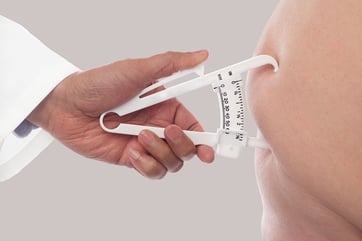See the NASM Weight Loss Specialization course for more information on this subject!
A quick online search for weight loss strategies reveals a plethora of “hormone-balancing” diets, supplements and medications. The premise behind these products is that hormones—tiny chemical messengers that regulate physiological processes—get out of balance, causing weight gain or foiling attempts to lose weight.
That seems like a reasonable claim, but is it true? What should you say when clients ask about hormones and weight management? In this article, we’ll provide answers on the links between body weight and five of the most talked about hormone imbalances: those relating to insulin, cortisol, the thyroid hormones, testosterone and estrogen. I’ll review the science and outline nutrition and exercise strategies to help your clients overcome weight loss plateaus and succeed at long-term weight loss.
The hormone issues discussed below often fade away with proper diet, exercise, sleep and stress management. Supplements and specialized diets typically address the symptoms of hormone imbalances, not the causes. Your clients may get better results if they understand the difference between the two.
Let’s dive in!
Table of Contents
1. Insulin
Insulin is the hormone that manages our blood sugar levels. One of its key roles is to signal the uptake of glucose (and nutrients) from the bloodstream into cells. Consuming excess calories—especially from sugary, calorie-laden processed foods—triggers an insulin response: The hormone tells tissues to take up the fuel.
Unneeded calories get converted into body fat. As people grow more overweight or obese, the body’s insulin response starts to malfunction, progressing from insulin sensitivity to insulin resistance, the stage when cells stop responding effectively to insulin. Insulin resistance is a key symptom of type 2 diabetes, which may require medication to restore insulin function.
The more your clients suffer from overweight or obesity, the worse their insulin sensitivity will typically be, meaning their bodies must pump out more insulin than normal to cope with each meal. Insulin resistance is the end of the spectrum; this is the hallmark of type 2 diabetes.
Because higher insulin levels accompany overeating, it’s tempting to ask: Does more insulin cause weight gain? Yes and no.
Carbohydrates have the biggest impact on insulin output. This led one group of experts to propose the “carbohydrate-insulin model” of obesity, which broadly states that carbohydrates are specifically more fattening than other macronutrients. While it’s an interesting hypothesis, the research doesn’t back it up, because eating too much fat also consistently induces insulin resistance and weight gain (Ferrannini et al. 1983; Boden et al. 1991; Belfort et al. 2005). In short, consuming too many calories—from carbohydrate or fat—leads to weight gain. Excessive weight gain eventually leads to insulin resistance.
In fact, excess energy will endanger any cell because the extra energy ramps up reactive oxygen species and inflammation, scrambling the insulin signal and leading to insulin dysfunction or resistance. It becomes a vicious cycle: The body’s ability to cope with excess energy gets worse from continuing to consume too many calories, accelerating the downward spiral that ultimately leads to type 2 diabetes and increased risk of death from all causes. Unfortunately, today’s world of hyperpalatable processed foods available 24/7 makes it difficult to fight off the urge to keep snacking.
 To sum up, weight gain is the most common cause of insulin dysfunction (though not all people with type 2 diabetes are overweight). Thus, when fitness clients who don’t have diabetes ask you about “lowering insulin” to lose weight, the best approach is to refocus their attention on the root cause—excess body fat. That means getting back to fundamentals, reducing caloric input and/or increasing energy expenditure. Of course, clients with a medical diagnosis of diabetes require guidance from a doctor and a nutrition expert.
To sum up, weight gain is the most common cause of insulin dysfunction (though not all people with type 2 diabetes are overweight). Thus, when fitness clients who don’t have diabetes ask you about “lowering insulin” to lose weight, the best approach is to refocus their attention on the root cause—excess body fat. That means getting back to fundamentals, reducing caloric input and/or increasing energy expenditure. Of course, clients with a medical diagnosis of diabetes require guidance from a doctor and a nutrition expert.
The bottom line is that insulin resistance goes hand in hand with caloric excess (Tam et al. 2010; Sims et al. 1973). Moreover, losing weight improves insulin sensitivity regardless of diet (Salans, Knittle & Hirsch 1968; Goodpaster et al. 1999). In short, to improve insulin sensitivity, your clients need a diet that provides a sufficient caloric deficit for weight loss and that they can adhere to over the long term.
Related Resource: NASM Body Fat Percentage Calculator
2. Cortisol
One of the body’s primary stress hormones, cortisol is produced in the adrenal glands, which sit atop the kidneys. When stress activates the sympathetic “fight-or-flight” nervous system, the brain signals the adrenal glands to ramp up cortisol, adrenaline and noradrenaline production. The feedback loop between the brain and the adrenal glands—called the hypothalamus-pituitary-adrenal axis (HPA axis)—responds to all types of life stressors, physical, mental and emotional.
Cortisol affects every cell in the body. It’s a catabolic hormone by nature, breaking down proteins into their amino acid building blocks to fuel the body during stress, infection, illness, trauma and so on. Does too much stress lead to weight gain? Strictly speaking, no. If you’re stranded on a desert island, surges in stress hormones like cortisol and adrenaline will increase fat breakdown as you burn fat and tap carbohydrates stored in the muscles and liver, ultimately leading to weight loss.
The rules of the game change, however, when calorie-dense processed foods are easily accessible. While appetite declines during acute bouts of stress, chronic low-grade stress appears to encourage the brain to seek out more energy-dense foods (Chao et al. 2017). This is where the stress-obesity connection comes from. Combining caloric excess (and persistently elevated insulin levels) with chronic low-grade stress appears to be the perfect recipe for weight gain and obesity.
Can supplements, a detox diet or medication magically help your clients cope better with stress? Not likely. The key to increasing resiliency—the capacity to cope with stress—can’t be found in a pill or supplement bottle. You need to help clients reassess the pillars of wellness: sleep, a balanced training plan (with adequate recovery) and nutrition.
Read also: How to Lower Cortisol
3. Thyroid
“My metabolism is broken!”
This common lament often blames weight management woes on the thyroid gland, which sets the body’s metabolic rate and produces hormones that influence how we think, feel, recover and perform.
Declining thyroid function often invites a diagnosis of hypothyroidism, in which the brain fails to instruct the thyroid gland appropriately, leading to insufficient hormone production. Hypothyroid symptoms may include fatigue, weight gain, brain fog, dry hair and skin, cold intolerance, and more.
Hypothyroidism is strongly associated with weight gain. Many people struggle with symptoms of thyroid dysfunction despite “normal” blood testing, meaning they don’t have a clear medical condition, but they do have suboptimal thyroid output. Though clients, trainers and even doctors may blame the thyroid for weight gain, the question of hormone balance remains: Is a sluggish thyroid causing the weight gain, or is it just a symptom?
Research suggests that medications can yield modest weight loss benefits for people with hypothyroidism (Agnihothri et al. 2014). The benefits occur in those whose level of thyroid-stimulating hormone (TSH) is above 5.0, well outside the normal TSH high range of 4.0. Because higher TSH numbers signal lower thyroid output, people with 5.0-plus TSH readings may well have a “sluggish thyroid.” But many people with suboptimal thyroid output are likely to be in the normal TSH range, and drug benefits may not apply to them.
What’s next? In a recent interview on my podcast, Shawn Arent, director of human performance at Rutgers University, pointed to evidence in the scientific literature showing that thyroid hormones can be a very useful marker for overtraining in athletes (Arent 2018). The heavy stress and/or high volume of an intense training program can cause elevation in thyroid markers. For nonathletes, chronic life stress from too much work, too little sleep or mental/emotional challenges can yield the same results.
What does all this mean for your clients? Thyroid markers that are mildly out of balance reflect heightened stress or inadequate recovery, so clients are pushing too close to the red line. The good news is, these clients probably don’t have a broken thyroid gland. They need to prioritize sleep, watch their nutrition and reduce stress levels (easier said than done, but you get the point).
From an exercise perspective, training load should be your top priority. Ensure that your program design applies proper overload and incorporates periods of training adaptation.
4. Testosterone
For many men, more testosterone means more muscle and a leaner physique, and the notion of improving testosterone levels remains front and center in many men, particularly those over 40. The blogosphere is full of anecdotes saying that boosting low testosterone—or low T—triggers fat burning and packs on lean mass. But how well do these stories of “hormone hypertrophy” hold up?
Research confirms that training the body leads to acute increases in testosterone, growth hormone and insulin-like growth factor-1. Moreover, the better the workout, the greater the hormone output. Seems like hormones trigger hypertrophy, right? Not quite.
Reminding us again that correlation is not causation, Brad Schoenfeld, director of the human performance laboratory at Lehman College in New York, notes that in his research lean muscle gains (highly beneficial for weight loss) occurred without the presence of these hormones (Schoenfeld 2013). Thus, the hormone hypertrophy hypothesis has been challenged.
Expert Eric Helms highlights how professional bodybuilders peaking for competition—at the height of their leanness and impressive physiques—all have minuscule testosterone levels (Helms 2018). Helms emphasizes that caloric restriction, in and of itself, is the biggest signal contributing to low levels of free testosterone (i.e., testosterone that is not bound to proteins in the blood). In fact, the prolonged and sustained caloric deficits required to be an elite bodybuilder mean it takes a pro 2–3 months for testosterone levels to return to normal.
What does this mean for the recreational client looking to burn fat and build muscle? Artificially boosting testosterone is not the answer. Instead, look at root causes of low testosterone. For clients carrying too much belly fat, losing weight should be the top priority. Belly fat is proinflammatory. Chronic inflammation can worsen blood glucose control and exacerbate weight gain. Abdominal adiposity also increases the activity of a hormone called aromatase, which helps convert testosterone into estrogen, further reducing testosterone levels.
What if your client doesn’t need to lose weight but still struggles with low testosterone? Once you’ve ensured that the client is eating enough, the next area to address is sleep—the second-most-likely cause of low testosterone, according to research. One study showed that healthy young men (average age 24.3) who got only 5 hours of sleep per night for 1 week saw their testosterone levels drop by 10%–15% (Leproult & Van Cauter 2011).
Sleep quality is also a factor. (Sleep apnea, a disorder characterized by pauses in breathing or periods of shallow breathing during sleep, compromises sleep quality.) A recent study by the University of Miami linked poor sleep quality to lower testosterone levels and found that for every hour of sleep loss (under 7 hours), men could expect a drop in testosterone (Patel et al. 2018).
 Re-examining a client’s training plan is crucial to restoring testosterone levels. A poorly periodized plan can quickly lead to inadequate recovery, overtraining and low testosterone levels. Elite and high-level athletes often see such effects when intense training pushes them into the overtraining zone. For the fitness enthusiast or weekend warrior, too much aerobic exercise, too many HIIT sessions and excessive volumes of training in the gym can all lead to inadequate recovery and low testosterone. A properly designed resistance training plan can prevent the profound drop in testosterone that may occur from too much volume, too much intensity or both.
Re-examining a client’s training plan is crucial to restoring testosterone levels. A poorly periodized plan can quickly lead to inadequate recovery, overtraining and low testosterone levels. Elite and high-level athletes often see such effects when intense training pushes them into the overtraining zone. For the fitness enthusiast or weekend warrior, too much aerobic exercise, too many HIIT sessions and excessive volumes of training in the gym can all lead to inadequate recovery and low testosterone. A properly designed resistance training plan can prevent the profound drop in testosterone that may occur from too much volume, too much intensity or both.
For more on this subject, check out "Can Foods Boost Testosterone?".
5. Estrogen
Social media is awash with claims that too much estrogen causes hormone imbalances and weight gain, particularly in women. Research suggests otherwise. The worldwide obesity epidemic exploded only in the last 40 years. Why did this “estrogen-dominant” phenotype not cause obesity in the previous 200,000 years of human history? Yes, adults with overweight or obesity often have higher estrogen levels than their slimmer peers—but estrogen isn’t causing the weight gain.
A quick review: Weight gain reflects the accumulation of fat cells that are highly proinflammatory. That disturbs blood glucose and insulin function, contributing to a downward spiral of poor regulation of insulin and cortisol while estrogen levels move higher. Once again, weight gain causes this hormonal disruption—not vice versa.
Since the “estrogen causes weight gain” claim is most often targeted to women, let’s look at exercise solutions with women in mind. Often, hourglass or pear-shaped body types do really well when training with heavier weights (e.g., powerlifting or strongman-type training). The most difficult task may be shifting the client’s mindset around training. Many women still fear heavy weights. The mental roadblock of “light weights and cardio” still persists, despite major progress in the fitness community—such as the growth of CrossFit® and, subsequently, the re-emergence of powerlifting—in the last decade.
Aim to get your clients to lift heavier loads at lower rep ranges (always with good form). This will ramp up lean muscle gains, increasing metabolic rate and supporting long-term weight loss. The new mantra “strong is the new skinny” seems quite apt in this scenario.
Address the Cause, Not the Symptoms
When your clients ask you about hormones and weight loss, help them understand the difference between symptoms and causes.
Many hormone imbalances are symptoms of weight gain, which triggers proinflammatory responses that affect the body’s output of insulin, cortisol, thyroid hormones, estrogen, testosterone and many other hormones. To lose weight, your clients don’t need to balance their hormones with fancy supplements, detox diets or medication.
They can achieve success by adopting an integrated wellness plan and addressing lifestyle factors such as lack of sleep and chronic stress. At the end of the day, compliance is king. Ultimately, as clients move along in their weight loss journey, finding a fitness strategy they can maintain over the long term is the key.
A NEAT Way to Burn Calories
Many trainers get too focused on the calories clients burn during their training session and forget about how much they move the rest of the day (Levine 2004). This other energy expenditure is called non-exercise activity thermogenesis (NEAT), and it actually makes up the bulk of calories burned in a day’s activity.
If your clients are sedentary, ensuring they’re getting enough movement during the day should be a top priority. The suggestion for 10,000 steps is a great place to start. In the short term, apps or fitness trackers can be very effective tools for showing clients how inactive they truly are.
It can take 8–12 weeks to build new movement habits. Walking to work, taking the stairs, parking as far away from the entrance as possible (where all the free spots are!), or doing a daily or nightly walk with friends or loved ones are all great ways to add more movement into the day.
If you want more context on NEAT, read this resource next!
Three Pillars of Wellness
The stress hormone cortisol isn’t bad—it’s essential for adaptation, survival and effective responses to stress. The problem is the impact of chronic low-grade stress on nutrition, movement and lifestyle choices. To address a cortisol imbalance, reassess these essential components of wellness.
SLEEP
Few of us get enough sleep. The average American sleeps about 6.5 hours per night, below the National Sleep Foundation’s recommended 7–9 hours (Hirshkowitz et al. 2015). Nighttime exposure to blue light from electronic devices further impairs sleep quality.
Your clients are more likely to be “under-recovered” than overtrained. Setting a sleep schedule—consistent bedtime, regular wakeup time and dedicated hour before sleep to unplug from technology—is a great first step in increasing resiliency.
BALANCED TRAINING PLAN
You probably have “chronic cardio” clients who run the same distance day after day, week after week. Not surprisingly, they struggle with improving fitness and losing weight. The trouble is that this repetitive stimulus (“junk miles”) takes a toll on the body, limiting effective recovery. Clients of this type will often crave sugars, rely on caffeine for energy, struggle with fitness and get stuck on a weight loss plateau.
Check out this downloadable PDF for more on tackling weight loss plateaus.
If you have a “chronic cardio” client, try this: Reduce aerobic training volume and provide a new stimulus by increasing intensity with either sprint interval training or high-intensity interval training. Use your expertise as a fitness professional to find the source of your client’s under-recovery, and you’ll see dramatic improvements.
NUTRITION
You will no doubt have conversations with clients about topics like meal frequency. While high meal frequency can be a great tool for bodybuilders and competitive athletes, the outcomes for recreational exercisers are more apt to be negative. Some people may think that increasing meal frequency will boost metabolism, thereby aiding fat loss.
However, this is not what the science shows. In a research review that looked at 15 studies on meal frequency, only one found a positive association between feeding frequency and improvements in body composition and weight loss (Schoenfeld, Aragon & Kreiger 2015). Keep things simple for your clients: Removing snacking opportunities and getting back to three meals a day can be a highly effective strategy for weight loss.
For more on nutrition and weight loss, see our free course on weight loss.
Grow Your Business by Reducing Waistlines
Help your clients learn the secret to long-term weight loss success with the NASM Weight Loss Specialization (WLS). Show clients how to embrace a healthier lifestyle as you design programs using the Optimum Performance Training™ (OPT™) model. Invest in your clients’ lives and futures, as well as your own.
REFERENCES
Agnihothri, R.V., et al. 2014. Moderate weight loss is sufficient to affect thyroid hormone homeostasis and inhibit its peripheral conversion. Thyroid, 24 (1), 19–26.
Arent, S. 2018. Assessing body composition, performance metrics & biomarkers. Dr. Bubbs Performance Podcast, Season 2, Episode 12. Accessed Jan. 4, 2019: drbubbs.com/season-2-podcast-episodes/2018/3/s2-episode-12-assessing-body-composition-performance-metrics-biomarkers-w-dr-shawn-arent-phd.
Belfort, R., et al. 2005. Dose-response effect of elevated plasma free fatty acid on insulin signaling. Diabetes, 54 (6), 1640–48.
Boden, G., et al. 1991. Effects of fat on insulin-stimulated carbohydrate metabolism in normal men. Journal of Clinical Investigation, 88 (3), 960–66.
Chao, A.M., et al. 2017. Stress, cortisol, and other appetite-related hormones: Prospective prediction of 6-month changes in food cravings and weight. Obesity (Silver Spring), 25 (4), 713–20.
Ferrannini, E., et al. 1983. Effect of fatty acids on glucose production and utilization in man. Journal of Clinical Investigation, 72 (5), 1737–47.
Goodpaster, B.H., et al. 1999. Effects of weight loss on regional fat distribution and insulin sensitivity in obesity. Diabetes, 48 (4), 839–47.
Helms, E. 2018. Nutrition for bodybuilders, hypertrophy and physique-focused athletes. Dr. Bubbs Performance Podcast, Season 2, Episode 7. Accessed Jan. 4, 2019: drbubbs.com/season-2-podcast-episodes/2018/2/s2e7-nutrition-for-bodybuilders-hypertrophy-and-physique-focused-athletes-w-dr-eric-helms-phd.
Hirshkowitz, M., et al. 2015. National Sleep Foundation’s updated sleep duration recommendations: Final report. Sleep Health, 1 (4), 233–43.
Leproult, R., & Van Cauter, E. 2011. Effect of 1 week of sleep restriction on testosterone levels in young healthy men. JAMA, 305 (21), 2173–74.
Levine, J.A. 2004. Nonexercise activity thermogenesis (NEAT): Environment and biology. American Journal of Physiology–Endocrinology and Metabolism, 286 (5), E675–85.
Patel, P., et al. 2018. Impaired sleep is associated with low testosterone in US adult males: Results from the National Health and Nutrition Examination Survey. World Journal of Urology, doi:10.1007/s00345-018-2485-2.
Salans, L.B., Knittle, J.L., & Hirsch, J. 1968. The role of adipose cell size and adipose tissue insulin sensitivity in the carbohydrate intolerance of human obesity. Journal of Clinical Investigation, 47 (1), 153–65.
Schoenfeld, B.J. 2013. Postexercise hypertrophic adaptations: A reexamination of the hormone hypothesis and its applicability to resistance training program design. Journal of Strength and Conditioning Research, 27 (6).
Schoenfeld, B.J., Aragon, A.A., & Kreiger, J.W. 2015. Effects of meal frequency on weight loss and body composition: A meta-analysis. Nutrition Reviews, 73 (2), 69–82.
Sims, E.A.H., et al. 1973. Endocrine and metabolic effects of experimental obesity in man. Recent Progress in Hormone Research, 29, 457–96.
Tam, C.S., et al. 2010. Short-term overfeeding may induce peripheral insulin resistance without altering subcutaneous adipose tissue macrophages in humans. Diabetes, 59 (9), 2164–70.
Wiegner, L., et al. 2015. Prevalence of perceived stress and associations to symptoms of exhaustion, depression and anxiety in a working age population seeking primary care—an observational study. BMC Family Practice, 16, 38.

















